Why Web Development Services Are Essential for Modern Business Success
Web development services encompass the complete process of building, maintaining, and optimizing websites and web applications for businesses. These services include:
- Frontend development – User interface and experience design
- Backend development – Server-side functionality and databases
- Full-stack solutions – Complete end-to-end development
- E-commerce platforms – Online stores with payment processing
- Content management systems – Easy-to-update website frameworks
- Ongoing maintenance – Security updates, performance optimization, and support
The numbers tell a compelling story. With over 1.09 billion websites online and 252,000 new sites created daily, businesses can’t afford to have a subpar web presence. Research shows that 68% of digital experiences start with a search engine, and 40% of visitors will abandon a site if it takes more than 3 seconds to load.
The stakes are higher than ever. A poorly designed website can kill your credibility before potential customers even read your content. Studies reveal that 94% of first impressions are design-related, and 75% of a website’s credibility comes from its design quality.
But here’s the challenge: choosing the right web development partner from the sea of options available. With over 160,000 website development service providers listed on platforms like Fiverr alone, how do you separate the wheat from the chaff?
That’s exactly what this roundup solves. We’ll break down the top web development services, compare their strengths and weaknesses, and help you make an informed decision that fits your budget and business goals.
I’m HJ Matthews, Business Development Manager at Brain Jar, and I’ve spent over 15 years helping businesses across industries – from aviation to automotive – steer the complex world of web development services. Through managing multiple online ventures and working with diverse clients, I’ve seen what separates exceptional web development partners from the rest.
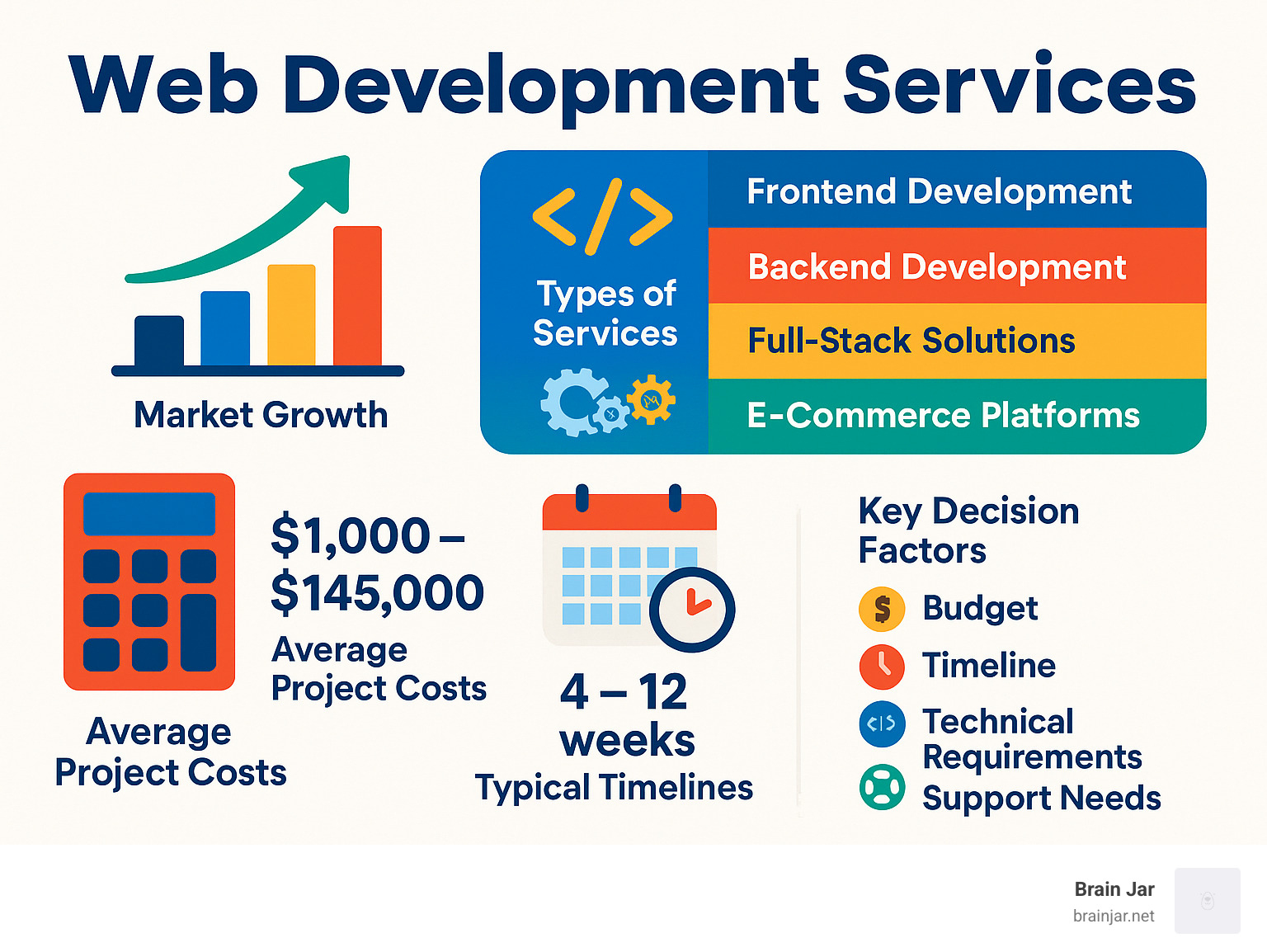
Understanding Web Development Services
Web development services aren’t just about making websites look good. I’ve seen too many business owners get confused about what they’re actually buying, and that confusion usually leads to disappointment and wasted money.
Think of it this way: if you’re building a house, web design is like hiring an architect to draw beautiful blueprints. Web development is hiring the construction crew to actually build the thing. You need both, but without solid development, even the prettiest design is just a picture.
What Are Web Development Services?
Web development services are the technical backbone that turns ideas into working websites and web applications. It’s the behind-the-scenes magic that makes buttons clickable, forms submittable, and payments processable.
When you hire professional developers, you’re getting expertise in custom coding using languages like HTML, CSS, JavaScript, PHP, and Python. They handle Content Management System integration so you can update your site without calling a developer every time you want to change a paragraph.
The technical side includes database design and server setup, quality assurance testing across different devices and browsers, hosting configuration, and security implementation with SSL certificates and protection against malware and hackers.
Benefits of Professional Web Development Services
The difference between amateur and professional web development services shows up in your bottom line.
Speed equals money. When your site loads in under 3 seconds, you keep 40% more visitors than slower sites. Professional developers know how to optimize code, compress images, and structure databases for lightning-fast performance.
Security isn’t negotiable anymore. With cyber attacks jumping 38% year-over-year, amateur websites are sitting ducks. Professional developers implement proper encryption, regular security patches, and follow industry best practices.
Your SEO success starts with clean code. Search engines love well-structured websites, and professional developers build that foundation from day one. Proper meta tags, clean URL structures, and optimized code architecture help you rank higher without paying for ads.
Scalability might seem like a future problem, but it’s not. I’ve seen too many businesses outgrow their amateur websites and need complete rebuilds. Professional development creates architecture that handles traffic spikes and business growth without breaking.
Finally, with over 3.5 billion smartphone users spending nearly 3 hours daily on their devices, your site needs to work perfectly everywhere. Professional developers ensure global reach through responsive design that looks and functions flawlessly across all devices and browsers.
Top Types of Web Development Services & When to Use Them
Choosing the right type of web development services feels like ordering from a menu written in a foreign language. Different businesses need completely different approaches. A local bakery doesn’t need the same web infrastructure as Amazon.
Let me walk you through the main types of web development services and when each one makes sense for your business.
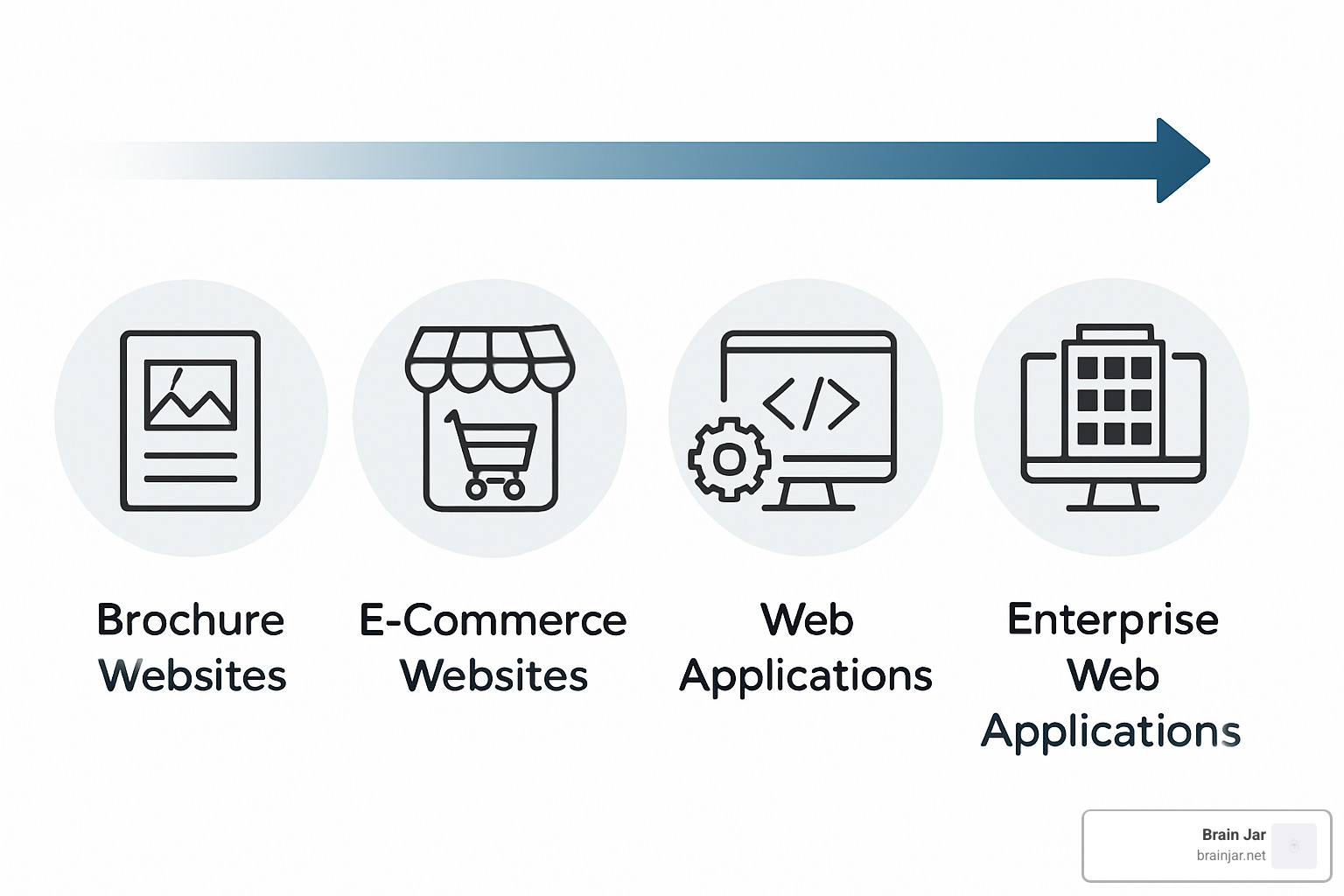
Business & Brochure Sites
Think of these as your digital handshake with the world. Business and brochure sites are clean, professional, and focused on one main goal: making your company look credible and trustworthy.
These sites work perfectly for service-based businesses like law firms, consulting companies, or local contractors. The sweet spot for brochure sites is typically 5 to 15 pages covering your services, about page, testimonials, and contact information. The budget usually ranges from $1,000 to $5,000.
E-Commerce Solutions
Online selling is a completely different beast. E-commerce development isn’t just about making products look pretty – it’s about creating a smooth path from “just browsing” to “take my money.”
The technical requirements get complex fast. You need secure payment processing, inventory management that updates in real-time, shopping carts that remember items across devices, and checkout processes that don’t frustrate customers.
| Feature | Shopify | Custom Build |
|---|---|---|
| Setup Time | 1-2 weeks | 8-16 weeks |
| Monthly Fees | $29-$299 | $0 (hosting only) |
| Customization | Limited | Unlimited |
| Scalability | Good | Excellent |
| Best For | Small-medium stores | Large enterprises |
E-commerce conversion rates typically hover between 1.84% and 3.71%, but professional development focused on user experience can push these numbers much higher.
Progressive Web Apps (PWAs)
PWAs are the cool kids on the block – they give you the best of both websites and mobile apps without the headaches of app store approvals or separate development teams.
What makes PWAs special is their offline functionality. Users can browse your content even when their internet connection is spotty. Pinterest saw a 60% increase in engagement after launching their PWA.
PWAs work particularly well for content-heavy sites, news platforms, e-commerce stores, or any business where mobile engagement is crucial.
Web Applications & Internal Tools
This is where web development services get really interesting. Web applications are custom-built solutions designed around your specific business processes.
These aren’t public-facing websites trying to attract customers. Instead, they’re focused on making your business run more efficiently. Think customer portals where clients can track project progress, internal dashboards that give managers real-time performance data, or inventory management systems.
Choose web application development when you have unique business processes that standard software can’t handle, need custom integrations between different systems, or want to streamline internal operations.
The Web Development Process & Timeline
Most businesses have no idea what actually happens during web development. Understanding these processes helps you spot quality providers and avoid costly surprises.
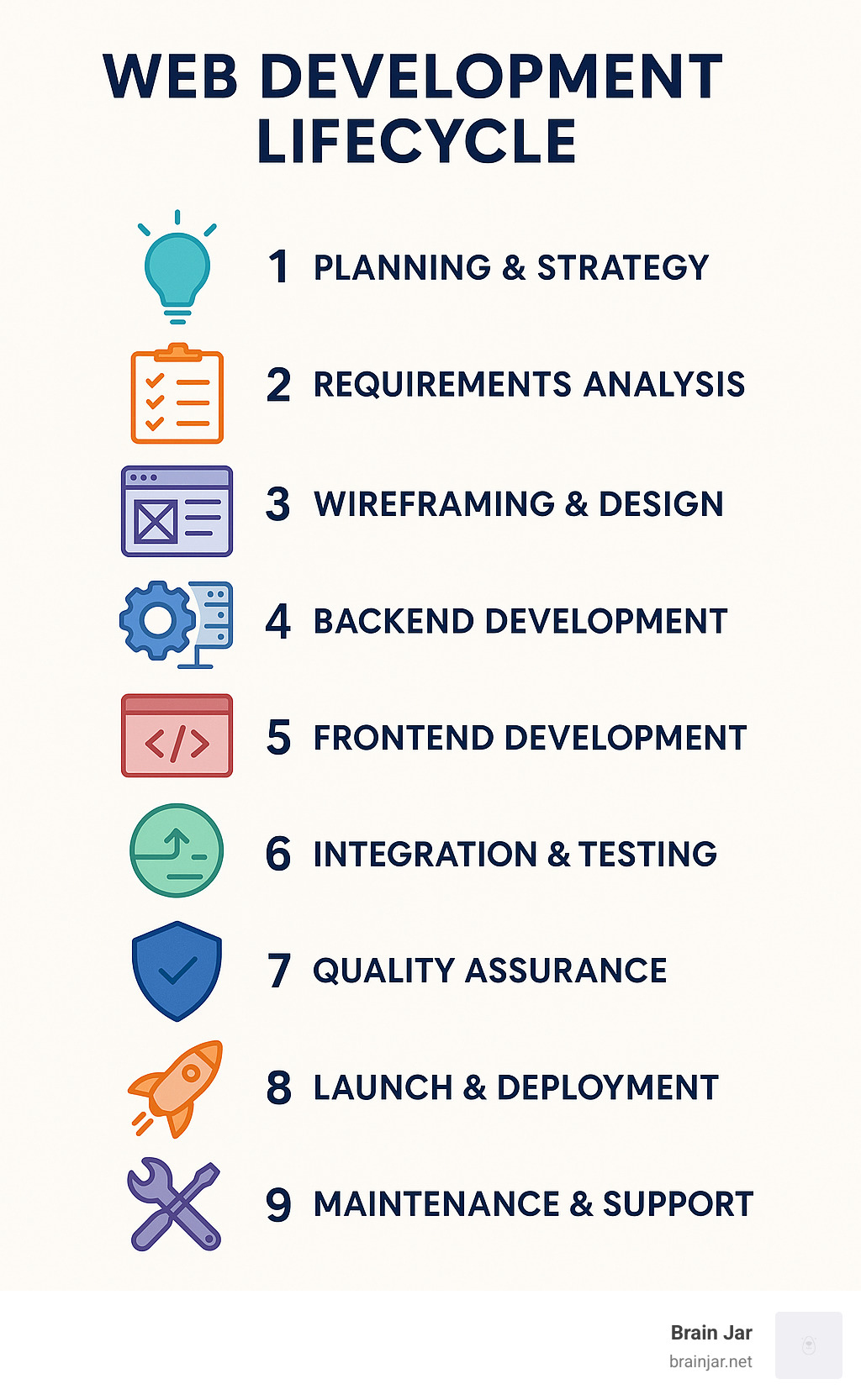
Think of web development like building a house. Planning and strategy come first, followed by requirements analysis where your developer figures out exactly what you need. Next comes wireframing and design – basically the blueprint phase. Then the real building begins with backend development and frontend development.
Integration and testing is where all the pieces come together. Quality assurance catches problems before your customers do. Finally, launch and deployment gets you live, followed by ongoing maintenance and support.
Typical Timeline for Web Development Services
Good web development services take time – there’s no way around it.
Simple business sites with 5-10 pages typically need 7-9 weeks total. That breaks down to one week planning, 2-3 weeks design, 3-4 weeks development, and a week for testing and launch.
E-commerce platforms are beasts of their own. Plan for 16-24 weeks minimum. You’re looking at 2-3 weeks planning, 4-6 weeks design and user experience work, 8-12 weeks development, and 2-3 weeks testing.
Enterprise applications require serious commitment – 23-32 weeks is standard. These projects include 4-6 weeks of findy and planning, 3-4 weeks architecture design, 12-16 weeks development for the first phase, and 4-6 weeks testing and refinement.
Methodologies That Shape Delivery
Most top web development services use proven methodologies rather than winging it.
Agile development breaks projects into 2-4 week chunks called sprints. You get regular updates, can provide feedback, and adjust course if needed. Research shows agile projects are 28% more successful than old-school waterfall approaches.
Scrum takes agile further with specific roles and regular check-ins. Daily standups, sprint reviews, and retrospectives keep everyone aligned.
Kanban uses visual boards to show project progress in real-time. It’s great for ongoing maintenance and continuous improvement projects.
Waterfall follows a linear path through defined phases. While latest research suggests agile approaches work better for most web projects, waterfall still makes sense for projects with fixed requirements.
Cost Breakdown & Value Comparison of Web Development Services
Web development services pricing varies wildly, and understanding what drives costs helps you make smarter decisions.
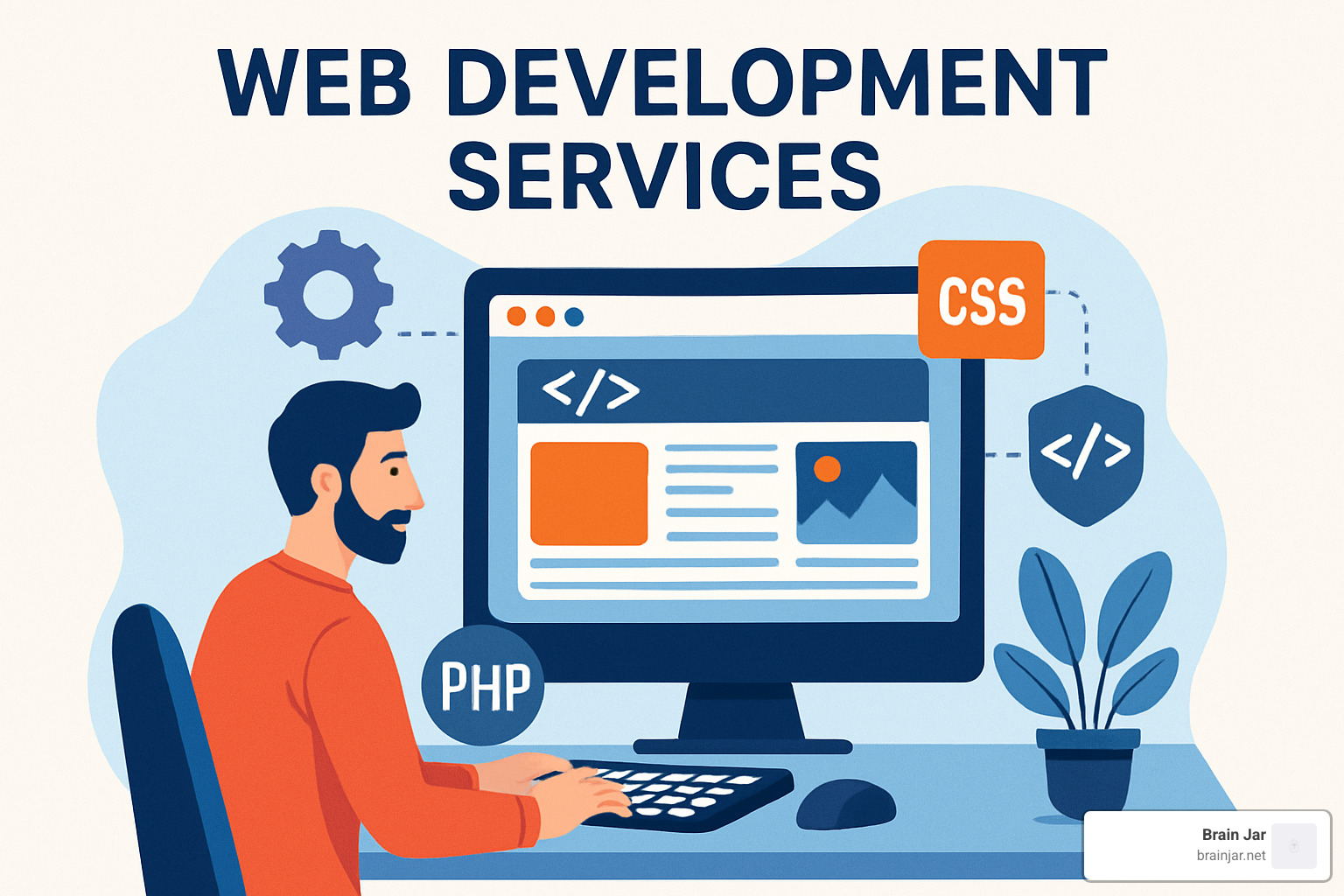
You can find someone to build a website for $500 on freelance platforms, or you can invest $500,000 in a custom enterprise solution. The difference isn’t just in the final product – it’s in the approach, expertise, and long-term value you receive.
What Impacts Price the Most?
Project scope and complexity drive the biggest cost differences. A simple brochure site with five pages requires fundamentally different resources than a custom e-commerce platform managing thousands of products.
Team experience and location create significant price variations. Senior developers with seven-plus years of experience deliver better results faster, but they command higher rates. Geographic location matters too – developers in major tech hubs typically charge premium rates.
Technology requirements can dramatically impact costs. Standard features using proven technologies are straightforward to implement. But cutting-edge capabilities like artificial intelligence integration or blockchain functionality require specialized expertise that comes at a premium.
Integration complexity often surprises clients with hidden costs. Connecting your new website to existing business systems, third-party APIs, or legacy databases can easily double development time.
Quality assurance and testing represent a crucial investment that many clients overlook. Professional testing across multiple devices, browsers, and user scenarios typically adds twenty to thirty percent to development time.
Sample Budget Ranges
Based on analyzing hundreds of projects across different industries, here’s what you can realistically expect to invest:
Basic business sites typically range from $1,000 to $5,000 and include five to fifteen pages with responsive design, contact forms, basic SEO optimization, and content management system integration. These projects usually take four to eight weeks.
Mid-level business solutions fall between $5,000 and $30,000 and offer custom design with advanced functionality, e-commerce capabilities or member portals, third-party system integrations, and comprehensive SEO optimization. Expect eight to sixteen weeks for completion.
Enterprise applications start at $30,000 and climb significantly higher depending on complexity. These custom web applications include complex workflows, multiple user roles and permissions, advanced security and compliance features, and scalable architecture designed for high traffic volumes.
Don’t forget about ongoing maintenance costs. Budget fifteen to twenty percent of your initial development investment annually for security updates, performance monitoring, content updates, and feature improvements.
The key is matching your investment to your business goals. The best web development services help you find that sweet spot where cost meets value.
How to Choose the Right Web Development Partner
Most businesses mess this up completely. They get impressed by pretty portfolios or chase the lowest price, then wonder why their project goes sideways three months later.
The real decision factors aren’t what most people think they are. Portfolio and pricing matter, but the companies that get the best results focus on communication, process, and long-term partnership potential.
Must-Ask Questions Before Signing
Start with the basics that trip up most projects. Ask exactly what’s included in their web development services package. You’d be amazed how many providers quote you for “website development” but charge extra for SSL certificates, basic SEO setup, or even hosting configuration.
Ownership is huge. Ask who owns the code and whether you can access it. Some providers essentially hold your website hostage by keeping the code locked away. You should own your digital assets, period.
Pin down their revision policy. How many rounds of changes are included? What happens when you need something tweaked after launch? Professional providers have clear policies here.
Talk to their actual clients, not just their portfolio pieces. Anyone can show you pretty screenshots. Ask for references from projects similar to yours, then actually call those people.
Get specific about timelines and contingencies. What happens if they miss the deadline? How do they handle unexpected complications? The best providers have clear processes for managing delays.
Understand their ongoing support model. Websites aren’t “set it and forget it” products. They need security updates, performance monitoring, and occasional fixes. Know what’s included in post-launch support and what costs extra.
Red Flags to Avoid
Run from vague estimates. When someone says your project will cost “somewhere between $5,000 and $25,000,” they haven’t actually analyzed your needs. Professional providers give detailed breakdowns that show exactly what you’re paying for.
No quality assurance process is a disaster waiting to happen. If they can’t explain how they test websites across different devices and browsers, expect problems after launch.
Poor documentation means future headaches. Providers who don’t document their work leave you stranded when you need updates or want to work with someone else later.
Unrealistic timelines usually mean cut corners. When someone promises to build your complex e-commerce site in two weeks, something’s going to suffer – usually quality, functionality, or both.
Communication problems during sales predict bigger problems later. If they’re slow to respond or hard to reach while trying to win your business, imagine trying to get support when you actually need help.
The best web development services providers treat you as a long-term partner, not a one-time transaction.
Latest Trends & Recommended Tech Stack for 2025
The web development landscape moves fast, and what worked last year might already be outdated. If you’re investing in web development services now, you want to make sure your site won’t look ancient in two years.
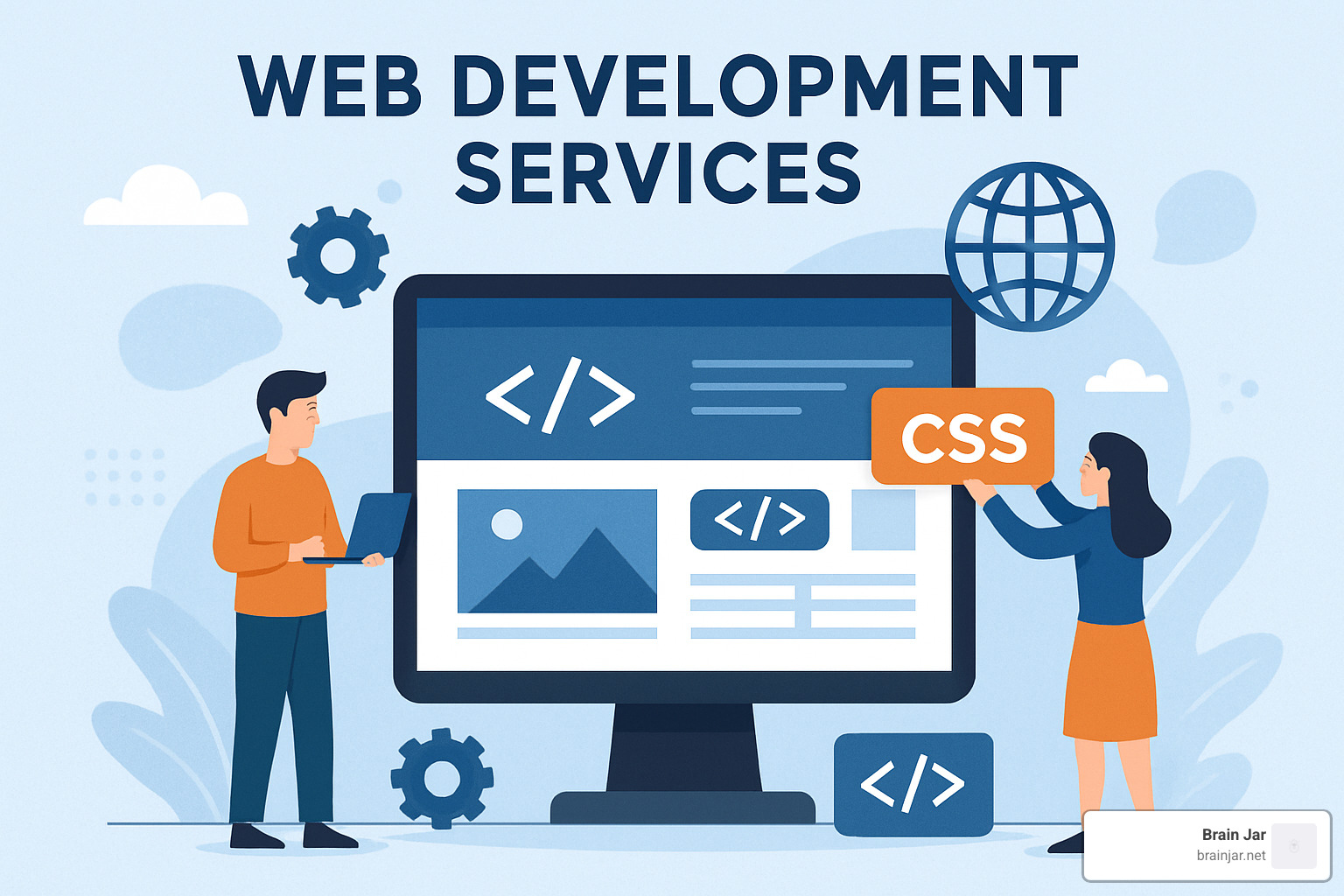
Artificial Intelligence is everywhere – and for good reason. The chatbot market is heading toward $9.4 billion by 2024, growing at nearly 30% annually. Smart web development services are building features like intelligent search that actually finds what users want, content that adapts to individual preferences, and customer service that handles routine questions automatically.
Voice search is changing how people find information. When someone asks their phone “Where’s the best pizza near me?” they’re not typing keywords – they’re having a conversation. Voice search adoption continues accelerating, which means websites need to understand natural language, not just search terms.
Progressive Web Apps keep proving their worth. Twitter saw their daily active users jump 65% after launching their PWA. These aren’t just mobile-friendly websites – they’re web applications that feel like native apps but work everywhere.
Dark mode has moved from trendy to essential. Beyond looking sleek, it reduces eye strain during late-night browsing and saves battery life on mobile devices. Users now expect it as a standard option.
Serverless architecture is making hosting smarter. Instead of paying for servers that sit idle most of the time, serverless only runs when someone actually uses your site. This means lower costs and better performance.
Web accessibility isn’t optional anymore. Legal requirements for digital accessibility are tightening, but more importantly, accessible design creates better experiences for everyone.
Headless CMS solutions are gaining ground because they solve a real problem. Traditional content management systems tie your content to one specific website design. Headless systems separate content from presentation, so you can use the same content across your website, mobile app, and any future platforms.
For 2025, the recommended tech stack focuses on proven technologies that deliver results: React or Vue.js for dynamic user interfaces, Node.js or Python for reliable server-side functionality, and PostgreSQL or MongoDB depending on your data complexity needs.
Cloud hosting platforms like AWS, Google Cloud, and Azure provide the scalability and security that growing businesses need, while headless CMS solutions like Strapi or Contentful give you flexibility for future growth.
The best web development services focus on building solutions that work reliably today while positioning you for tomorrow’s opportunities.
Frequently Asked Questions about Web Development Services
How long does it take to build a website or web app?
A basic business website with 5-10 pages typically takes 7-9 weeks from start to finish. This includes planning, design, development, and testing. Don’t let anyone tell you they can do it properly in 2-3 weeks.
E-commerce platforms are a different beast entirely. You’re looking at 16-24 weeks for a professional online store with proper payment processing, inventory management, and security features.
Enterprise applications with custom functionality can take 6 months or more. These are complex systems that need to integrate with your existing business processes.
The timeline killers I see most often are unclear requirements at the start, multiple design revision cycles, and content delays. When clients come prepared with their content and have clear goals, projects move much faster.
How much will professional web development services cost me?
Template-based business sites typically run $1,000 to $5,000. These work well if you need something simple and don’t require custom functionality.
Custom business websites with unique design and functionality range from $5,000 to $30,000. This is where most of our clients land because it gives you a professional presence that stands out from your competition.
E-commerce platforms start around $20,000 and can go well beyond $100,000 depending on complexity.
Enterprise applications begin around $50,000 and can reach $500,000 or more. These are custom solutions built specifically for your business processes.
The cheapest option often costs more in the long run. Poor security, slow performance, and limited scalability will hurt your business and cost more to fix later than doing it right the first time.
What ongoing support and maintenance should I expect?
Your website isn’t a “set it and forget it” investment. It’s more like a car – it needs regular maintenance to keep running smoothly and safely.
Security updates happen monthly at minimum. Performance monitoring is ongoing. Content management training is usually included upfront, but you’ll have questions as you use the system. Regular backups should happen automatically. Analytics and reporting help you understand how your website is performing.
Here’s the budget reality: plan for 15-20% of your initial development cost annually for comprehensive maintenance. So if you invested $20,000 in your website, budget $3,000-$4,000 per year for proper maintenance.
This isn’t an expense – it’s insurance for your digital investment.
Conclusion
Finding the right web development services partner feels overwhelming when you’re drowning in options. But here’s what I’ve learned after 15 years in this business: the best partnerships happen when you find a team that genuinely cares about your success, not just your project budget.
The web development landscape changes fast. What worked five years ago might actually hurt your business today. That’s why the smartest businesses choose partners who stay ahead of the curve – teams that understand modern web development services include everything from AI integration to voice search optimization.
At Brain Jar, we’ve watched too many business owners get excited about flashy demos, only to end up with websites that look great but don’t actually drive results. The difference between good and great web development services isn’t just technical skill – it’s the ability to connect your business goals with the right technology choices.
The best web development partners become true business allies. They ask tough questions about your customers, challenge assumptions about your industry, and build solutions that grow with your business. They’re the ones who call you when they spot a security vulnerability, not the ones who disappear after launch.
Whether you’re launching your first website or rebuilding a complex web application, success comes down to choosing a partner who combines technical expertise with genuine business insight. Look for teams that provide detailed project scoping, use proven development methodologies, and offer the kind of ongoing support that keeps your digital presence strong.
Your website isn’t just code and design – it’s often the first impression potential customers have of your business. Make sure that impression is backed by professional web development services that deliver real results.
Ready to build something amazing? Contact Brain Jar today to discuss how our full-cycle web development solutions can turn your vision into reality.

